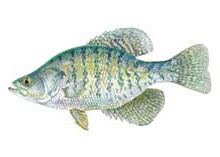Freshwater Fish - Species
Species Specific Regulations
White crappie
Freshwater Fishing License required.
Complete fishing regulations
White crappie (Pomoxis annularis)
Description: (Anatomy of a Fish)
Overall body color is a gray-green with a silver side and white belly. The dark spots on the side tend to form wavy vertical bars. The white crappie has a deep and highly compressed body, a large mouth that extends rearward to beneath the eye, and a concave nape.
Range: Statewide
Average Length: 6.7 - 20.9 inches
Average Size: ½ to 1¼ pounds, approximate maximum size five-pounds
South Carolina State Record: 5 pounds 1 ounce (1949)
Life Expectancy: Approximately 10 years
Preferred Habitat
The two species of crappie are found in almost all waters with the exception of mountain streams. They are more abundant in large impoundments, natural lakes and backwaters.
White crappie are more tolerant of turbid conditions with the black crappie preferring clearer lakes.
Food Habits
- Young crappie feed on invertebrates such as zooplankton and insects. When they reach a size of about 7 inches, fish become more prevalent in the diet.
- In large impoundments, adult crappie feed on threadfin shad and small gizzard shad throughout the year; however, they will feed extensively on mayfly nymphs during the summer months.
Spawning
- As water temperatures approach 60° F, the male crappie will prepare a nest by fanning out a shallow depression on top of sand, gravel or mud in 2 to 8 feet of water.
- Nests range from 8 to 15 inches in diameter and are usually found in colonies, with as many as 30 nests found in a 9-square yard area.
- Females deposit from 3,000 to 15,000 eggs per spawn, but may spawn with several different males. Large females have the potential to lay up to 150,000 eggs.
- The male guards fertilized eggs for 2 to 3 daysuntil hatching after 2 to 3 days and continues to guard for an additional 3 to 4 days until fry leave the nest.
Miscellaneous
The black crappie is very similar to the white crappie, differing slightly only in some body characteristics, color patterns and habitat preference. In most impoundments, one species or the other will predominate. The crappie is one of the most popular sport fishes in South Carolina. It is relatively easy to locate and catch and it has a very good flavor.
Crappie are often found in large numbers around piers and brush. These loose aggregations are not really schools of fish but they can appear to come and go as they are fished out of a small area. The South Carolina Department of Natural Resources constructs and marks brush piles designed to attract crappie as a service to anglers. These fish attractors do a good job of attracting crappie but fishing pressure can reduce the number of fish at the site for short periods of time.
Commonly Mistaken Species
Some species of fish that are commonly mistaken for this species:
Literature Cited
Rohde, Fred C, Arndt, Rudolf G., Foltz, Jeffery W., Quattro, Joseph M. 2009. Freshwater Fishes of South Carolina. University of South Carolina Press, Columbia, South Carolina.
Wildlife and Freshwater Fisheries Division. 2009. South Carolina Guide to Freshwater Fishes.
Fish Illustration by Duane Raver


